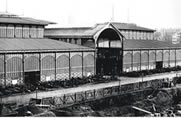The Digital Paris Project
Interractive Maps and Digital Reconstruction
Latest News
New Project To Begin
HIST 336 “Ancien Regime and Revolution” will explore early seventeenth-century urbanization in terms of the Place des Vosges and the Place Dauphine.
Flash Coming Soon
During the Fall semester of 2011, students will continue adding flash componets to the Les Halles de Paris 3D model.
Les Halles History

Les Halles was the traditional central market of Paris. In 1183, King Philippe II Auguste enlarged the marketplace in Paris and built a shelter for the merchants, who came from all over the Ile de France to sell their foodstuffs. In the 1850s, a series of massive glass and iron buildings (Victor Baltard Architect) were constructed to "modernize" the site. Les Halles was also known as the "belly of Paris".
Unable to compete in the new market economy, in need of massive repairs, and contributing to significant traffic problems, the colorful ambience previously associated with the bustling area of merchant stalls disappeared in 1971 when Les Halles was demolished. The wholesale market was relocated to the suburb of Rungis.
The site was to become the point of convergence of the RER, a network of new express underground lines which was completed in the 1960s. Three lines leading out of the city to the south, east and west were to be extended and connected in a new underground station. For several years, the site of the markets was an enormous open pit, nicknamed "le trou des Halles" (trou = hole), regarded as an eyesore at the foot of the historic church of Saint-Eustache.
Construction was completed in 1977 on Châtelet-Les-Halles, Paris's new urban railway hub. The Forum des Halles, a partially underground multiple story commercial and shopping center, opened in 1979. The building was criticized for its design and the city of Paris has undertaken consultations regarding the remodeling of the facility and immediate area.